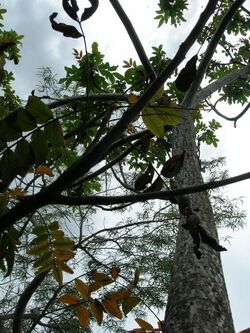Biology:Rhus sandwicensis
| Rhus sandwicensis | |
|---|---|

| |
| Scientific classification | |
| Kingdom: | Plantae |
| Clade: | Tracheophytes |
| Clade: | Angiosperms |
| Clade: | Eudicots |
| Clade: | Rosids |
| Order: | Sapindales |
| Family: | Anacardiaceae |
| Genus: | Rhus |
| Species: | R. sandwicensis
|
| Binomial name | |
| Rhus sandwicensis A.Gray
| |
| Synonyms | |
|
Rhus chinensis var. sandwicensis (A.Gray) Deg. &
Greenwell | |
Rhus sandwicensis, commonly known as neneleau,[2] neleau or Hawaiian sumac, is a species of flowering plant in the cashew family, Anacardiaceae, that is endemic to Hawaii. It is small tree, reaching a height of 4.5–7.5 m (15–25 ft) and a trunk diameter of 10–30 cm (3.9–11.8 in). Neneleau inhabits dry, coastal mesic, mixed mesic and wet forests at elevations of 180–610 m (590–2,000 ft) on all main islands.[1]
The Latin specific epithet of sandwicensis refers to the "Sandwich Islands," as the Hawaiian Islands were once called, and named by James Cook on one of his voyages in the 1770s. James Cook named the islands after John Montagu, 4th Earl of Sandwich for supporting Cook's voyages.[3]
Uses
Neneleau wood was used by Native Hawaiians to make laʻau lomi lomi (massage sticks) and ʻumeke (calabashes).[4]
Cultural significance
Neneleau is mentioned in the Kumulipo, the Hawaiian creation chant.[4]
References
- ↑ 1.0 1.1 Little Jr., Elbert L.; Roger G. Skolmen (1989). "Neneleau, Hawaiian sumac". Common Forest Trees of Hawaii (Native and Introduced). United States Forest Service. http://www.ctahr.hawaii.edu/forestry/trees/CommonTreesHI/CFT_Rhus_sandwicensis.pdf. Retrieved 2010-02-10.
- ↑ "Rhus sandwicensis". Natural Resources Conservation Service PLANTS Database. USDA. https://plants.usda.gov/core/profile?symbol=RHSA2. Retrieved 21 October 2015.
- ↑ "Native Plants Hawaii - Viewing Plant : Nestegis sandwicensis". http://nativeplants.hawaii.edu/plant/view/nestegis_sandwicensis.
- ↑ 4.0 4.1 Medeiros, A. C.; C.F. Davenport (1998). "Auwahi: Ethnobotany of a Hawaiian Dryland Forest". Cooperative National Park Resources Studies Unit, University of Hawaiʻi at Mānoa. pp. 35–36. http://www.hear.org/naturalareas/auwahi/ethnobotany_of_auwahi.pdf. Retrieved 2008-04-11.
External links
Wikidata ☰ Q7321571 entry
 |

